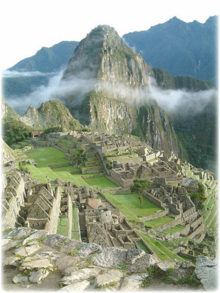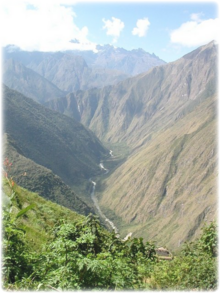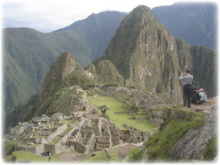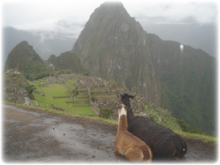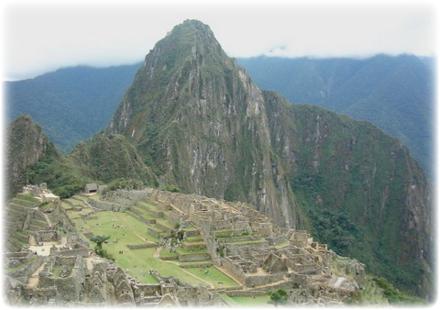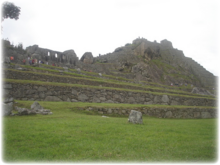
General Information
| Access Country : | Peru |
Destination Activities
Activity Details
Machu Picchu is a pre-Columbian Inca site located at 2,430 meters (7,970 ft) above sea level on a mountain ridge above the Urubamba Valley in Peru, about 44 miles northwest of Cusco. Often referred to as "The Lost City of the Incas", Machu Picchu is probably the most familiar symbol of the Inca Empire. It was built around the year 1450 and abandoned a hundred years later, at the time of the Spanish conquest of the Inca Empire. Forgotten for centuries by all except for a few locals, the site was brought to worldwide attention in 1911 by Hiram Bingham, an American historian. Since then, Machu Picchu has become an important tourist attraction; it was declared a Peruvian Historical Sanctuary in 1981 and a UNESCO World Heritage Site in 1983.
One theory maintains that Machu Picchu was an Incan "llacta": a settlement built up to control the economy of the conquered regions and that it may have been built with the purpose of protecting the most select of the Incan aristocracy in the event of an attack. Based on research conducted, most archaeologists now believe that, rather than a defensive retreat, Machu Picchu was an estate of the Inca emperor Pachacuti. Evidence has been presented that the site was selected based on its position relative to sacred landscape features, especially mountains that are in alignment with key astronomical events.
Cultural Activities
Take the time to walk around the site; there are many places to see and explore. Although it is not necessary, taking a guided tour does provide a deeper insight into the ancient city, its uses, and information on the geography of it. Also, be sure to wake up early to miss the thousands of people that visit the site each day, or stay till closing time. The first buses start running at 5:40am, which will give you an hour or two in the pleasant light of dawn but before the full force of the sun begins hammering the mountainside. (If you plan to stay past 10am, sunblock is requisite.)
» Temple of the Sun - Near the summit of the main city, the stonework on the temple is incredible. Look closely and you will see that there are a variety of stone walls throughout the city. Most are rough stones held together with mud, the common stone walls found throughout the world. But many buildings or parts of buildings are done with the more distinctive and impressive closely-fit stonework. The temple is the absolute pinnacle of this technology. Observe it from the side, descending the stone staircase in the main plaza.
» Intiwatana
» Temple of the Three Windows
» Main Temple
» Condor - The tour guides will try to tell you that this was a temple, but look closely: between the wings of the condor is a chamber with grooves cut in the stone to secure manacles, a walkway behind where a torturer may walk to whip the prisoner's backs, and a scary looking pit to let the blood of prisoners drain. Clearly the condor was a symbol of cruel justice, but a sanitized version is told for the benefit of tourists.
The following sights involve some legwork:
» Walk back up the Inca trail away from the site and up the hill to the Sun Gate (or Inti Punku); from here you can see back down each valley offering a excellent views. It's a gentle walk (probably 45 mins tops round trip) and well worth it. If you stay in Aguas Calientes, it is possible to get here early enough to catch the sunrise from here.
» Walk up Waynapicchu; this is the "second" hill seen in the many photos. It's a steep but short walk offering very impressive views over the site. Well worth the effort! Waynapicchu also has ruins atop its peak. Two cautionary notes: The hike is somewhat strenuous and not advised for visitors who are elderly, pregnant or have heart/lung conditions. Also, the steep stairs and cliffs you must walk along at the summit can be terrifying for those who are afraid of heights. Note that the path to Waynapicchu closes at 4pm and you're not allowed to enter after 1pm. Entry is limited to 400 people per day. On busy tourist days, the limit will be reached by 10-11am. It is recommended you go straight here first thing. You will be required to sign in; remember your number (or the time you signed in) so that you can find yourself in the book to sign out again.
» If you have some time at hand or really longing for a sparkle of solitude you can also walk to the Moon Temple (Templo de la Luna) and the Great Cave (Gran Caverne). It's a long walk and the sites aren't really rewarding, but unexpected wildlife can be seen (wild spectacled bears have been reported). This hike is also quite interesting because partway through you leave behind the mountain terrain and enter a more conventional forest. The caves can be reached either by hiking down the trail from the peak of Wachupichu (which includes some semi-harrowing but fun near-vertical descents) or by the split from the main Wachupichu trail (look for the sign that says Gran Carvern). Be sure to bring plenty of water for this long hike.
Admission
Visiting Machu Picchu isn't cheap. The entrance fee is about $40. With the train ticket to Machu Picchu Pueblo, also formerly known as Aguas Calientes and a night's accommodation it easily adds up to US$100. Visitors to Machu Picchu leave from Cusco. From there, a visitor has the following options to reach Machu Picchu:
» Train: The most common way is to take the train to Machu Picchu in the morning, explore the ruins for a few hours and return to Cusco in the afternoon. The train terminates at Puente Ruinas station, where buses take tourists up the mountain to Machu Picchu. The Machu Picchu station is located at Aguas Calientes; this is not the station used by tourists on a day trip.
» Bus: From Machu Picchu pueblo Aguas Calientes a traveler can take one of the frequent buses to the ruins (US$6 each way). It is also possible to walk the distance, about 2 hours (8 km).
and
» On foot:
Hiking
The Inca Trail is one of the world's most famous hiking trails. Starting from the Sacred Valley of the Urubamba River and ending at the breathtaking ruins of Machu Picchu, the trail takes three to five days to complete. The trail itself winds through a combination of high altitude mountain ranges (the Andes) and dense subtropical forest.
The Inca Trail to Machu Picchu is actually three routes, which all meet up near Inti-Pata, the 'Sun Gate' and entrance to Machu Picchu. The three trails are known as the Mollepata, Classic and One Day trails, with Mollepata being the longest of the three. Passing through the Andes mountain range and sections of the Amazon rainforest, the Trail passes several well-preserved Inca ruins and settlements before ending at the Sun Gate on Machu Picchu Mountain. The two longer routes require an ascent to beyond 12,000 ft (3,660 m) above sea level, which can result in altitude sickness. A maximum of 500 people, including guides and porters, are permitted to begin the trail every day. As a result, the high season books out very quickly. Note that the trail is closed every February for cleaning.
The four-day trail or Classic Trail starts from one of two points; km 88 or km 82, on the Urubamba River and 88 km and 82 km from Ollantaytambo. The first day is relatively easy, covering no more than 13 km in a few hours, passing by the Inca ruins of Llaqtapata, a site used for crop production and which has remained well preserved. Day two includes the ascent to Warmiwanusca or Dead Woman's Pass, which, at 4,215 m above sea level, is the highest point on the trail. Day three starts with the final climb to Dead Woman's Pass, although some groups climb to the top of the pass on the second day and camp 600m below it on the other side at Pacaymayu. The views from the top provide excellent views of nearby mountains such as Salkantay and Veronika. After a second pass, is the site of Sayaqmarka, perched atop a sheer cliff. After Sayaqmarka, the Trail continues through thick cloud forest and jungle, filled with tropical flowers and colorful orchids. The third and final pass is Phuyupatmarka. The final day sees a descent past Wiñay Wayna, an impressive and well-preserved Inca site, where the one-day trail meets up with the main route.
An alternative way (half the time) to get to Machu Picchu is by trekking the "Short Inca Trail" or "two day Inca Trail", "the Sacred Inca Trail" or the "Camino Real de los Incas". The trek starts at Km104 (104 kilometers along the railway from Cusco) and involves a four hour walk uphill to Winay Wayna and a couple of hours further to Machu Picchu making it ideal for trekkers wanting to experience at least a part of the Inca Trail but haven't got the time (or energy) to complete the full 4 day trek. You must employ the services of a professional guide or trek as part of an organized tour group. Trekkers continue their trek all the way to Machu Picchu and spend the night in a hotel in Aguas Calientes. Apart from the waterfalls just before Winay Wayna there are no other places to refill your water bottle up (purify before drinking). Therefore it is recommended that you start the trek with at least 1.5 liters of water.
Photography
If you have adventure-travel related experience in this region and would like to add content to this page, please contact us
to learn how.
